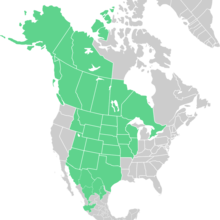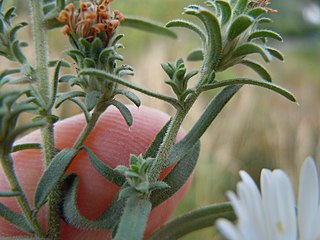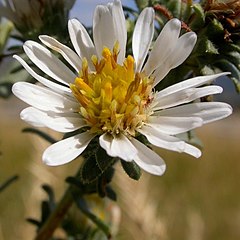bio.wikisort.org - Plant
Symphyotrichum falcatum (formerly Aster falcatus) is a species of flowering plant in the family Asteraceae. Commonly called white prairie aster and western heath aster,[5] it is native to a widespread area of central and western North America.
| Symphyotrichum falcatum | |
|---|---|
 | |
Conservation status | |
| Scientific classification | |
| Kingdom: | Plantae |
| Clade: | Tracheophytes |
| Clade: | Angiosperms |
| Clade: | Eudicots |
| Clade: | Asterids |
| Order: | Asterales |
| Family: | Asteraceae |
| Tribe: | Astereae |
| Subtribe: | Symphyotrichinae |
| Genus: | Symphyotrichum |
| Subgenus: | Symphyotrichum subg. Virgulus |
| Species: | S. falcatum |
| Binomial name | |
| Symphyotrichum falcatum | |
| Varieties[2] | |
 | |
| Native distribution[2][3] | |
| Synonyms[2] | |
|
Basionym
Species var. commutatum[4]
| |
Description
White prairie aster blooms July–November depending on variety and location. It is colonial or cespitose and grows 10–80 centimeters (4–31 inches) tall. It has hairy stems and hairy, grayish-green and firm entire leaves.[6]
On the outside of the flower heads of all members of the family Asteraceae are small specialized leaves called "phyllaries", and together they form the involucre that protects the individual flowers in the head before they open.[lower-alpha 1][7] The involucres of S. falcatum are campanulate (bell-shaped) and usually 5–8 mm (1⁄4–3⁄8 in) long. The outer phyllaries are spreading to reflexed (bent sharply backwards) and oblanceolate to spatulate in shape. The inner phyllaries are linear-lanceolate. They are in 3–4 unequal rows, meaning they are staggered and do not end at the same point.[6]
The flower heads have 15–35 usually white ray florets, sometimes blue or pink, that are typically 18–30 millimeters (3⁄4–1+1⁄8 inches) long. These surround a center of roughly the same number of disk florets that start as yellow and become brown with age.[6]
- Bracts, involucres, and phyllaries.
- Close-up of ray and disk florets
Chromosomes
Symphyotrichum falcatum has a base number of x = 5.[8] Diploid, tetraploid, and hexaploid cytotypes with respective chromosome counts of 10, 20, and 30 have been reported, depending upon the infraspecies, as follows:
- S. spathulatum var. falcatum: 2n = 2x = 10, 2n = 4x = 20, and 2n = 6x = 30.[9]
- S. spathulatum var. commutatum: 2n = 6x = 30.[3]
Taxonomy
Symphyotrichum falcatum is one of the two species within Symphyotrichum sect. Ericoidei. The other is S. ericoides.[10] The species was first formally described by John Lindley in 1834 as Aster falcatus.[11]
Two varieties are recognized:
- S. falcatum var. falcatum, cespitose with up to ten stems from caudices,[6] and known commonly as white prairie aster, western heath aster, creeping white prairie aster, falcate aster, and little grey aster.[12]
- S. falcatum var. commutatum, communal with stems growing from rhizomes.[6] Common names of this variety include white prairie aster, western heath aster, and little grey aster, as well as cluster aster.[13]
S. falcatum is one of the parents of the two allopolyploidal Symphyotrichum species S. ascendens[14] and S. defoliatum.[8]
Distribution and habitat
S. falcatum var. falcatum is native from Alaska, Yukon, and Northwest Territories in the north, western Canada from British Columbia to Manitoba, in the United States from Idaho east to Minnesota, west to Wyoming and south to New Mexico and Arizona, then north to Utah. It is also native to northern Mexico.[2]

S. falcatum var. commutatum has no subarctic presence, extends farther east into Ontario, the South Central and upper Midwestern United States, and farther south in Mexico.[4]
Conservation
NatureServe lists it as Secure (G5) worldwide, Critically Imperiled (S1) in Alaska, Imperiled (S2) in Manitoba, Vulnerable (S3) in Yukon, and Possibly Extirpated (SH) in Iowa. It is an exotic species in Ontario, Missouri, and Massachusetts.[1]
Uses
The Zuni people call S. falcatum var. commutatum by the name ha'mopiawe and mix the ground blossoms with yucca suds to wash newborn infants.[15] Quoting American ethnologist Matilda Coxe Stevenson:
The blossoms, ground to a fine meal, are sprinkled into a bowl of yucca suds used for bathing a new-born infant. This medicine is said to make the hair grow on the head and to give strength to the body. The remedy belongs to all women.[15]
The Ramah Navajo use the plant in a decoction to make a lotion as a remedy for snake bites.[16]
Notes
- See Asteracae § Flowers for more detail.
Citations
References
- Brouillet, L.; Semple, J.C.; Allen, G.A.; Chambers, K.L.; Sundberg, S.D. (2006a). "Symphyotrichum falcatum". In Flora of North America Editorial Committee (ed.). Flora of North America North of Mexico (FNA). Vol. 20. New York and Oxford. Retrieved 23 July 2021 – via eFloras.
- Brouillet, L.; Semple, J.C.; Allen, G.A.; Chambers, K.L.; Sundberg, S.D. (2006b). "Symphyotrichum falcatum var. commutatum". In Flora of North America Editorial Committee (ed.). Flora of North America North of Mexico (FNA). Vol. 20. New York and Oxford. Retrieved 23 July 2021 – via eFloras.
- Brouillet, L.; Semple, J.C.; Allen, G.A.; Chambers, K.L.; Sundberg, S.D. (2006c). "Symphyotrichum falcatum var. falcatum". In Flora of North America Editorial Committee (ed.). Flora of North America North of Mexico (FNA). Vol. 20. New York and Oxford. Retrieved 23 July 2021 – via eFloras.
- GBIF Secretariat (2019a). "Symphyotrichum falcatum (Lindl.) G.L.Nesom". gbif.org. GBIF Secretariat. Retrieved 24 November 2020.
- GBIF Secretariat (2019b). "Symphyotrichum falcatum var. commutatum (Torr. & A.Gray) G.L.Nesom". gbif.org. GBIF Secretariat. Retrieved 24 November 2020.
- IPNI (2020). "Aster falcatus Lindl". International Plant Names Index (IPNI). Royal Botanic Gardens, Kew; Harvard University Herbaria & Libraries; Australian National Botanic Gardens. Retrieved 24 November 2020.
- Morhardt, S.; Morhardt, E. (2004). California Desert Flowers: An Introduction to Families, Genera, and Species. Berkeley, Los Angeles, and London: University of California Press. ISBN 0520240030.
- NatureServe (2 July 2021). "Symphyotrichum falcatum White Prairie Aster". NatureServe Explorer (explorer.natureserve.org). Arlington, Virginia: NatureServe. Retrieved 23 July 2021.
- POWO (2021a). "Symphyotrichum falcatum (Lindl.) G.L.Nesom". Plants of the World Online. Royal Botanic Gardens, Kew. Retrieved 23 July 2021.
- POWO (2021b). "Symphyotrichum falcatum var. commutatum (Torr. & A.Gray) G.L.Nesom". Plants of the World Online. Royal Botanic Gardens, Kew. Retrieved 23 July 2021.
- Semple, J.C. (n.d.). "Symphyotrichum subg. Ascendentes". University of Waterloo (UWaterloo.ca). Waterloo, Ontario: University of Waterloo. Archived from the original on 22 July 2021. Retrieved 23 July 2021.
- Semple, J.C. (16 October 2019). "Virguloid Asters". University of Waterloo (UWaterloo.ca). Waterloo, Ontario: University of Waterloo. Archived from the original on 23 July 2021. Retrieved 23 July 2021.
- Semple, J.C. (14 May 2021). "Symphyotrichum ascendens — Long-leaved Aster, Intermountain Aster, Western Aster". University of Waterloo (UWaterloo.ca). Waterloo, Ontario: University of Waterloo. Archived from the original on 22 July 2021. Retrieved 23 July 2021.
- Stevenson, M.C. (1915). "Ethnobotany of the Zuñi Indians". Smithsonian Institution-Bureau of American Ethnology (SI-BAE) Annual Report. Washington: U.S. Government Printing Office. 30: 84. Retrieved 23 July 2021 – via Biodiversity Heritage Library.
- USDA, NRCS (2014). "Symphyotrichum falcatum". The PLANTS Database (plants.usda.gov). Greensboro, North Carolina: National Plant Data Team. Retrieved 23 July 2021.
- Vestal, P.A. (1952). "The Ethnobotany of the Ramah Navaho". Papers of the Peabody Museum of American Archaeology and Ethnology. 40 (4): 48. Retrieved 23 July 2021 – via abstract at Native American Ethnobotany DB (naeb.brit.org).
External links
- Symphyotrichum falcatum in the CalPhotos photo database, University of California, Berkeley
Другой контент может иметь иную лицензию. Перед использованием материалов сайта WikiSort.org внимательно изучите правила лицензирования конкретных элементов наполнения сайта.
WikiSort.org - проект по пересортировке и дополнению контента Википедии


